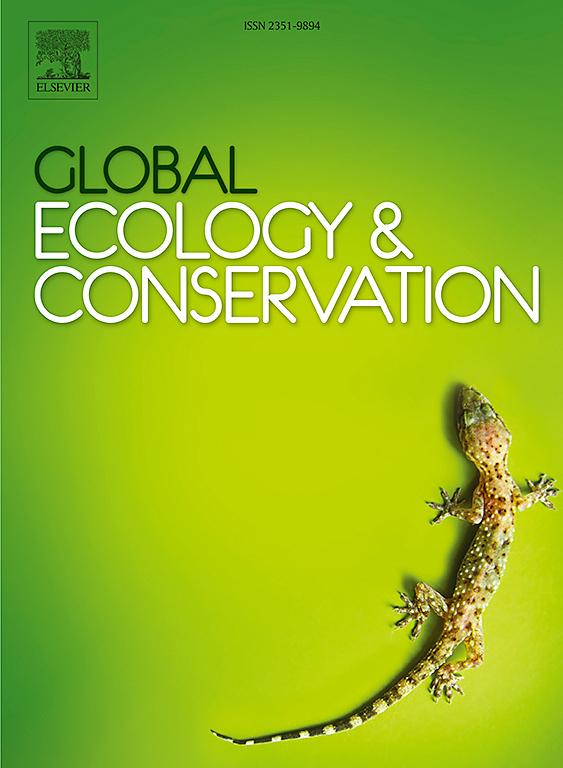金沙江流域水坝和鱼类通道设施对龟尾鱼纵向运动的影响
IF 3.5
2区 环境科学与生态学
Q1 BIODIVERSITY CONSERVATION
引用次数: 0
摘要
水电大坝的建设提供了能源、水资源管理和防洪,但也带来了相当大的生态挑战。在金沙江流域,水电站大坝的建设破坏了古蠓的纵向运动。本研究采用树突连通性指数(DCIP)来评估水坝对该物种连通性的影响,并研究在高效率和有限效率的情况下,通过鱼类通道设施增强连通性的潜力。结果表明,从1990年1月到2024年1月,DCIP得分明显下降,从100下降到11.52(高效)和9.68(有限效率)。未来,随着所有水坝和上游设施的完工,预计得分将略有提高,达到13.21分(高效率)和9.7分(有限效率)。此外,整合单一的上游或下游设施可以增强连通性,尽管程度有限。三种增加双向设施的方案均在高效条件下得分可达100分,而在有限效率条件下得分仅为12.83分。在这两种情况下,计划1和计划2的第一阶段,只增加了一种类型的设施(上游或下游),最高的DCIP分数改善低于计划3(相同数量的设施),同时增加了两种类型。研究强调了建立高效的双向鱼道设施的重要性,以确保鱼的有效纵向运动。研究结果与减轻大坝对连通性的负面影响有关,可为物种保护和河流健康管理提供参考。本文章由计算机程序翻译,如有差异,请以英文原文为准。
Effects of dams and fish passage facilities on the longitudinal movement of Coreius guichenoti in the Jinsha River Basin
The construction of hydropower dams has provided energy, water management, and flood control, yet it has also presented considerable ecological challenges. In the Jinsha River Basin, the construction of hydropower dams has disrupted the longitudinal movement of Coreius guichenoti. This study employs the Dendritic Connectivity Index for Potadromous (DCIP) to evaluate the impact of dams on the connectivity of this species and to investigate the potential for enhancing connectivity through fish passage facilities under scenarios of high and limited efficiency. The results demonstrate a notable decline in DCIP scores between January 1990 and January 2024, with a reduction from 100 to 11.52 (high efficiency) and 9.68 (limited efficiency). In the future, scores are expected to improve slightly to 13.21 (high efficiency) and 9.7 (limited efficiency), as all dams and upstream facilities are completed. Furthermore, incorporating a single upstream or downstream facility can enhance connectivity, albeit to a limited extent. For the three plans of adding bidirectional facilities at all dams, scores could reach 100 under high efficiency, but they only reached 12.83 under limited efficiency. In both scenarios, the highest DCIP score improvements in Phase I of Plans 1 and 2, which added only one type of facility (either upstream or downstream), were lower than in Plan 3 (an equal number of facilities), which added both types simultaneously. The study emphasizes the importance of constructing efficient bidirectional fish passage facilities to ensure the effective longitudinal movement of Coreius guichenoti. The results are related to mitigating the negative impacts of dams on connectivity and can provide a reference for species conservation and river health management.
求助全文
通过发布文献求助,成功后即可免费获取论文全文。
去求助
来源期刊

Global Ecology and Conservation
Agricultural and Biological Sciences-Ecology, Evolution, Behavior and Systematics
CiteScore
8.10
自引率
5.00%
发文量
346
审稿时长
83 days
期刊介绍:
Global Ecology and Conservation is a peer-reviewed, open-access journal covering all sub-disciplines of ecological and conservation science: from theory to practice, from molecules to ecosystems, from regional to global. The fields covered include: organismal, population, community, and ecosystem ecology; physiological, evolutionary, and behavioral ecology; and conservation science.
 求助内容:
求助内容: 应助结果提醒方式:
应助结果提醒方式:


